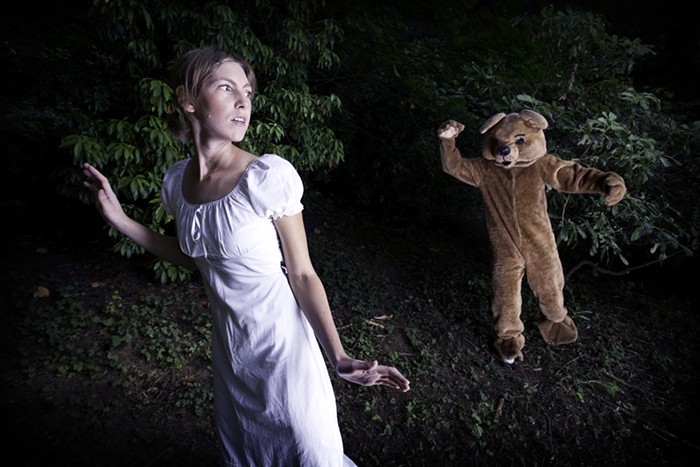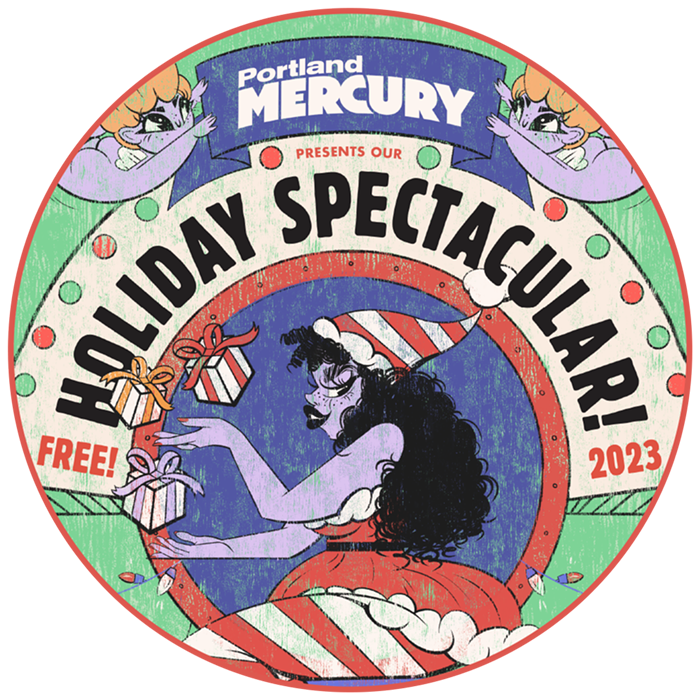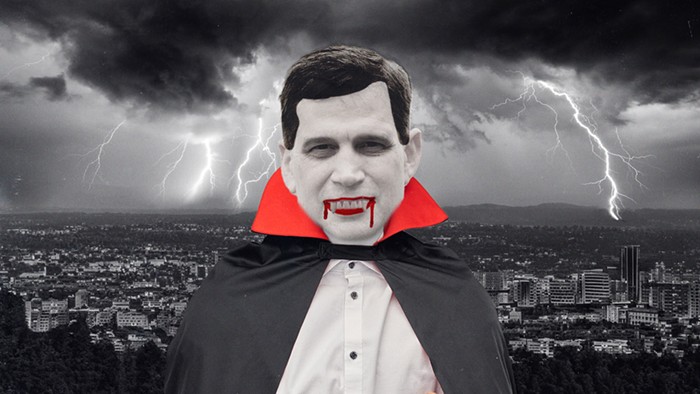Nick Hallett's Rainbow Passage is based on a diagnostic text by speech scientist Grant Fairbanks. It's a description of rainbows—the science, history, and myth of them—but its content is secondary to its purpose: it also contains every sound in the English language. Hallett's composition, for voices, synthesizer, and bass clarinet, presents the text musically and ties the form and content of that piece together.
It's like he's thrown the English language into a prism, or through a thousand drops of rain, and seen it refracted into its manifold phonetic parts. The performance Saturday night was gorgeously realized. Local artists The Julians, Golden Retriever, and Holcombe Waller joined Hallett on stage. It's not a loud piece, not big enough to drown out much talking in the wide open warehouse space at The Works. Yet, there was barely a voice heard that wasn't on the stage.
The idea that this is an exhaustive text kept coming back to me. You could have a list of English phonemes and check them off one by one until you were done. It could be a game: an enormous bingo card, with each of the boxes representing a sound—you would win a blackout by the end of the night.
Through that exhaustiveness, it's the expansiveness and the illimitability of sound and language that Hallett explores. A text like this is naturally limited by English, as there are sounds in other languages unrepresented in ours. But it's also limited by the mouth—tooth, lip, tongue, cheek. What I kept thinking about was the way the instrumentation and the vocals challenged each other to make new sounds, to imitate each other and be unlike each other.
There was a section near the middle that seemed rather improvised, when the musicians were joined by Holland Andrews of Like a Villain, who sang and played clarinet. There was an interesting play involved, voice against voice against synthesizer and clarinet and bass clarinet. It got a little noodly, and a little overlong, but it led back into a repetition of the beginning of the text, sung by Holcombe Waller, whose voice was just unnervingly beautiful—incredible, almost, through the reverb and echo.
The lights went down and the stage was lit by a Brock Monroe light installation: white light refracted through prismatic lenses. Rainbows swept across the performers and stage. Suddenly it seemed to be a science experiment; I felt like a kid, my little mind blown by something as simple as a prism—this is something I've understood since gradeschool, but not seen in this light, so to speak. That light is separable into color, the way language is separable into sound.
Language is just sounds; sounds can be sung or played, twisted and changed; sounds don't mean the same thing; they don't have to mean anything. For example, “exhaustive” can mean “awakening.” The text of the Fairbanks “Rainbow Passage” is past the jump, if you want to read it, or sing it, or play it on your clarinet.
RAINBOW PASSAGE
When the sunlight strikes raindrops in the air, they act as a prism and form a rainbow. The rainbow is a division of white light into many beautiful colors. These take the shape of a long round arch, with its path high above, and its two ends apparently beyond the horizon. There is , according to legend, a boiling pot of gold at one end. People look, but no one ever finds it. When a man looks for something beyond his reach, his friends say he is looking for the pot of gold at the end of the rainbow. Throughout the centuries people have explained the rainbow in various ways. Some have accepted it as a miracle without physical explanation. To the Hebrews it was a token that there would be no more universal floods. The Greeks used to imagine that it was a sign from the gods to foretell war or heavy rain. The Norsemen considered the rainbow as a bridge over which the gods passed from earth to their home in the sky. Others have tried to explain the phenomenon physically. Aristotle thought that the rainbow was caused by reflection of the sun’s rays by the rain. Since then physicists have found that it is not reflection, but refraction by the raindrops which causes the rainbows. Many complicated ideas about the rainbow have been formed. The difference in the rainbow depends considerably upon the size of the drops, and the width of the colored band increases as the size of the drops increases. The actual primary rainbow observed is said to be the effect of super-imposition of a number of bows. If the red of the second bow falls upon the green of the first, the result is to give a bow with an abnormally wide yellow band, since red and green light when mixed form yellow. This is a very common type of bow, one showing mainly red and yellow, with little or no green or blue.













